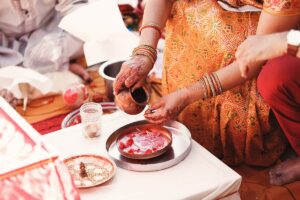Who among us hasn't had a grandmother offer us chamomile tea to soothe a sore stomach or put a tea leaf on a scratch? These simple pieces of wisdom, passed down through generations, are a piece of the much larger and deeper world we know. folk medicine under the name.
Folk medicine (also known as traditional medicine or indigenous medicine) is a collection of traditional and experience-based healing and health care techniques. It is a system of knowledge, practices, and skills passed down from generation to generation, deeply rooted in the traditions of different cultures and indigenous peoples, and whose purpose is to maintain health and treat disease.
Natural remedies and folk medicine have been pillars of human health for millennia and have retained their place in the daily lives of billions of people today. World Health Organization (WHO) estimates that a large proportion of the world's population still uses traditional healing methods in primary health care.
In this article, we embark on a journey to discover this rich and diverse world. We'll look at how widely folk medicine is used today; what ancient traditions, from Chinese medicine and Indian Ayurveda to the herbal wisdom of our own ancestors, are, and how this knowledge can complement our modern understanding of health and well-being.
TABLE OF CONTENTS
Use of traditional medicine around the world: a global overview
Folk medicine in different cultures
Estonia
China
India
Peru
When to choose folk medicine and when to consult a doctor?
Natural selection in our daily lives
Use of traditional medicine around the world: a global overview
Although the term traditional medicine may conjure up images of something distant and old-fashioned, it is a vibrant and indispensable part of healthcare for billions of people today. The range of its uses is impressive. From the WHO 2019 report The data obtained show that folk medicine usage worldwide remains 24–71% between, depending on the region, research method and definition.
The biggest difference comes from region to region, and country-specific data shows very different pictures. In developing countries Traditional medicine is often the primary and, unfortunately, the only available aid, while in developed countries it is more of a conscious choice that complements conventional medicine.
- Africa countries still rely on up to, according to WHO 80% of the population to rely on traditional healers and herbal medicines for their primary health care, which are usually more accessible, affordable, and culturally accepted.
- In Asia, the picture is diverse. For example, in India, the traditional medicine system AYUSH (Ayurveda, Yoga, Unani, Siddha and Homeopathy) strongly integrated healthcare and national reports indicate a significant use of these methods. In China however, a large portion of the population, especially the elderly and patients with chronic diseases, regularly use traditional Chinese medicine services in conjunction with Western medicine.
- In Western countries, the trend is on the rise. In the United States, national surveysthat about a third of adults use traditional medicine, mainly as a complementary alternative to conventional medicine. In European countries The use of traditional medicine varies from 11.6% in Hungary to 43.9% in Lithuania. Behind the growing popularity in Western countries is a broader shift towards a more holistic approach to well-being. People are looking for ways to actively take care of their health, relieve the stresses of modern lifestyles, and reduce the side effects of medications.
Recognizing the global importance of traditional medicine, the World Health Organization has also set a goal of integrating it into national health systems. WHO's new strategy for the years 2025–2034 aims to improve access to traditional, complementary and integrated medicine for all people, while ensuring that the solutions offered are safe, evidence-based and people-centred. The aim is not to pit traditional and modern medicine against each other, but to find ways in which they can safely and effectively complement each other, providing the best possible care.
Folk medicine in different cultures
The profound meaning of folk medicine is revealed when we examine the heritage of specific cultures, where generations have communed with nature, seeking relief from ailments and balance in life. The tradition of each people reflects its history, geography, beliefs and worldview. Whether it is the herbal wisdom of the Estonian forest people, the complex philosophical system of China or the spiritual heritage of the shamans of South America - everywhere the goal is the same: to maintain and restore health in harmony with nature.
Estonia
Unlike major philosophical systems, Estonian folk medicine is primarily tangible and practical, a wisdom accumulated over generations and passed down orally. Although spirituality had its own role – it was practiced both in rituals and in the village sage or "witch" – this was not the basis of the system. Rather, it was the difficult and isolated conditions that forced our ancestors to rely on what the forest, swamp, and meadow offered. The main thing was knowledge of plants and the skillful use of sauna steam. Sauna It was also a place where illnesses were treated, cups were made, alms were given, blood was poured, blood collectors worked there, and people went to the sauna to give birth.
The legacy of the Estonian ancient people lives on strongly today. Local medicinal herbs, such as St. John's wort, nettle, linden blossoms and blackcurrant, have been used for centuries and their popularity remains. This is also confirmed by impressive numbers: according to wholesale data, Estonians buy an average of 650,000 packages from pharmacies per year, or 20 tons of herbal preparationsThis means that the average Estonian resident consumes about ten grams of herbal preparations and drinks nearly 20 cups of herbal tea per year.
A good example of the meeting of tradition and science is St. John's wortIn Estonia, this plant has been traditionally used to relieve mood disorders and nervous tension. Today, St. John's wort has been widely studied and its preparations are also used in evidence-based modern medicine.
China
Traditional Chinese Medicine is one of the world's oldest and most complex systems of folk medicine, with a history spanning over 2,000 years. It is based on a profound philosophy that health is the result of a balance between the body's vital energy (Qi) and opposing forces (Yin and Yang). Disease occurs when this balance is disrupted. The goal of Chinese medicine is to restore harmony, using acupuncture, herbal medicine, massage and nutritional counseling.
Traditional medicine has always been central to China, both in the past and today. Unlike many other countries where traditional medicine has been relegated to the role of an alternative, it is integrated into the national healthcare system in China. In hospitals, both Western doctors and traditional medicine specialists work side by side. For chronic diseases, pain syndromes and stress-related ailments, many Chinese people prefer traditional methods.
Called the “Root of Life” ginseng is one of the most valued herbs in Chinese medicine. It is considered a powerful adaptogen – a substance that helps the body adapt to stress, increasing endurance and vitality. Ginseng is used to provide energy, ward off fatigue and improve general well-being. It is a great example of a plant that is used not to treat a specific disease, but to balance the entire body.
India
 India has given the world Ayurveda or “science of life” (ayur – life, veda – science/knowledge). It is a holistic system that is more than 5,000 years old, which treats the human being as a whole, body, mind and soul. Similar to Chinese medicine, it is an experiential science of life, which considers human health to be based on both a personal approach and a holistic worldview. The basic principle of Ayurveda is that a person achieves physical, mental and emotional health by living in harmony and in harmony with nature. Treatment includes a personalized diet, herbal preparations, meditation, yoga, and cleansing procedures.
India has given the world Ayurveda or “science of life” (ayur – life, veda – science/knowledge). It is a holistic system that is more than 5,000 years old, which treats the human being as a whole, body, mind and soul. Similar to Chinese medicine, it is an experiential science of life, which considers human health to be based on both a personal approach and a holistic worldview. The basic principle of Ayurveda is that a person achieves physical, mental and emotional health by living in harmony and in harmony with nature. Treatment includes a personalized diet, herbal preparations, meditation, yoga, and cleansing procedures.
Today, Ayurveda and other aspects of traditional medicine are officially recognized as part of the medical system in India. A separate ministry has been created for this purpose (AYUSH), which administers Ayurveda, Yoga, Unani, Siddha, Sowa Rigpa and homeopathy all aspects, from educational standards and research to the network of hospitals and clinics. At the same time, yoga, meditation and Ayurvedic principles have spread around the world as popular wellness practices.
Turmeric – the golden yellow spice – is an integral part of Indian cuisine and medicine. Turmeric has been used in Ayurveda for centuries for its powerful anti-inflammatory and antioxidant properties. Today, “golden yellow milk” (turmeric milk) is a popular drink in Western countries, demonstrating the arrival of ancient wisdom into modern wellness culture.
Peru
Spanning both the lush Amazon rainforest and the rugged peaks of the Andes, Peru is home to some of the richest flora and fauna in the world. traditional medicine to tradition.
The traditional medicine there is based on the belief that nature is alive and has a soul. The healer, who is called healer, is a mediator between the visible world and what they perceive as the spiritual world. The causes of illness are often seen in mental imbalance or the influence of negative forces. Healing is achieved through special ceremonies, songs (Icarus) and often with the help of very potent plants that help both cleanse the body and restore a person's spiritual balance. This approach, where the biochemical effects of plants and the rituals associated with them are intertwined, is radically different from the Western understanding.
A good example of a gift from Peruvian nature that has found its way around the world is the high altitude Andes mountain maca root. Since pre-Inca times, maca prized for its ability to provide energy and increase endurance. Today, maca powder is a popular “superfood” and dietary supplement around the world, used to support hormonal balance, provide energy, and improve overall vitality. It is a prime example of a plant whose beneficial properties have gained widespread recognition beyond its original cultural and spiritual context.
When to choose folk medicine and when to consult a doctor?
The answer lies not in opposition, but in the wisdom to understand the strengths and limitations of both systems. Both folk medicine and modern medical science have their own place, and the ability to use them correctly is the key to a holistic approach. Together they complement each other - one supports the body's natural processes, the other offers the opportunity to intervene when natural means are no longer enough.
Natural medicines, herbs and traditional practices can be part of a daily lifestyle to support overall health and are well suited to relieving minor ailments – for example, supporting digestion, reducing stress or strengthening immunity. At the same time, it is important to value the possibilities of modern medicine with its ability to intervene when nature is no longer enough. In cases of acute illnesses, serious injuries or unclear symptoms, modern treatment and timely diagnosis can be life-saving.
Natural selection in our daily lives
The wisdom of our ancestors does not only reside in ancient books or distant cultures. The basic principles of folk medicine can also be applied to our busy, modern lives. Holistic well-being does not begin with complex rituals, but with small, conscious choices we make every day.
Food as the first medicine. One of the principles of Ayurveda is that “Let food be thy medicine and medicine be thy food.” A colorful and varied diet is the best source of natural vitamins and minerals:
-
- A handful of black currants, sea buckthorn berries, or bell peppers is the best natural vitamin C to support the immune system.
- Sunflower seeds, almonds, and spinach are excellent sources of natural vitamin E, which protects our cells.
- Natural magnesium, found in dark leafy greens (like kale), pumpkin seeds, and even high-quality dark chocolate, helps you relax and relieve muscle tension.
Movement. Our bodies are designed to move, but that doesn’t necessarily mean a hard workout in the gym. An early morning jog, a walk in the woods, or gardening are all great ways to boost your body and mind. Regular exercise, especially in the fresh air, is one of the best ways to support your body’s natural production of happy hormones. It’s like a natural dopamine, improving mood, motivation, and focus.
Sunlight. The main natural source of vitamin D is the sun. This vital vitamin is necessary for the absorption of calcium, which ensures strong bones and teeth, but also plays an important role in the functioning of the immune system and regulating mood. Unfortunately, there is not enough sunlight in Estonia all year round, and therefore it is usually advisable and necessary to take a vitamin D supplement during the dark period to prevent deficiency and maintain health.
Rest and peace of mind. Endless activity without rest is a surefire path to burnout. Every day, you should find a moment to just be. It could be a cup of calming chamomile tea before bed, five minutes of deep breathing in the middle of the workday, or a screen-free hour in the evening. By consciously disconnecting ourselves from external noise, we give our nervous system a chance to recover and find inner balance again – a practice that has been valued in all ancient health traditions.
Folk medicine – ancient wisdom for modern people
Our journey into the world of folk medicine has taken us from grandma's chamomile tea to the ancient philosophies of China, the science of life in India, and the depths of the Peruvian rainforest. We have seen that folk medicine is not a single monolithic system, but a rich and diverse heritage that reflects each culture's unique relationship with nature and health. At the heart of all these traditions is a deep respect for nature and the understanding that humans are part of a greater whole.




